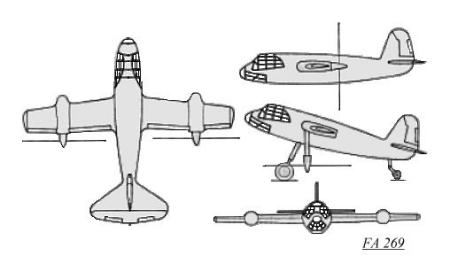 The Focke Achgelis 269 "convertiplane" was designed in 1943,
after it was considered that enough experience had been gained in the helicopter
field. The purpose of the "convertiplane" was to combine the
vertical landing and takeoff characteristics of the helicopter with the
much higher cruising speed and fuel economy of the airplane. The FA 269
was of a mid-wing configuration, with a slight sweepback of the leading
edge and a compound taper on the trailing wing. Each wing had an engine
(either a Daimler Benz 601 or 605) mounted beyond midspan that drove a
very large span pusher propeller. In level flight these propellers were
in a normal rear-facing position, but for takeoff and landing the propellers
could pivot downward through about an 85 degree arc. There was a special
pivoting gearbox at the front of each engine, from which a drive shaft
passed back between the engine cylinder banks to drive its propeller behind
the wing trailing edge. In the completely down position, the propellers
were almost parallel to the ground. A very long tailwheel undercarriage
was thus necessitated, which retracted into the fuselage. A crew of two
sat in a stepped cockpit located in the extreme nose, with the underside
being extensively glazed also. This project was abandoned in 1944 due to
the considerable development that would have been needed for the special
gearboxes, drives, pivoting mechanisms and the propeller pitch control
systems for use in landings and takeoffs.
The Focke Achgelis 269 "convertiplane" was designed in 1943,
after it was considered that enough experience had been gained in the helicopter
field. The purpose of the "convertiplane" was to combine the
vertical landing and takeoff characteristics of the helicopter with the
much higher cruising speed and fuel economy of the airplane. The FA 269
was of a mid-wing configuration, with a slight sweepback of the leading
edge and a compound taper on the trailing wing. Each wing had an engine
(either a Daimler Benz 601 or 605) mounted beyond midspan that drove a
very large span pusher propeller. In level flight these propellers were
in a normal rear-facing position, but for takeoff and landing the propellers
could pivot downward through about an 85 degree arc. There was a special
pivoting gearbox at the front of each engine, from which a drive shaft
passed back between the engine cylinder banks to drive its propeller behind
the wing trailing edge. In the completely down position, the propellers
were almost parallel to the ground. A very long tailwheel undercarriage
was thus necessitated, which retracted into the fuselage. A crew of two
sat in a stepped cockpit located in the extreme nose, with the underside
being extensively glazed also. This project was abandoned in 1944 due to
the considerable development that would have been needed for the special
gearboxes, drives, pivoting mechanisms and the propeller pitch control
systems for use in landings and takeoffs. Span: 10.0 m (32' 10") Length:8.9 m (29' 2.7") Max. Speed: 600 km/h (373 mph)

